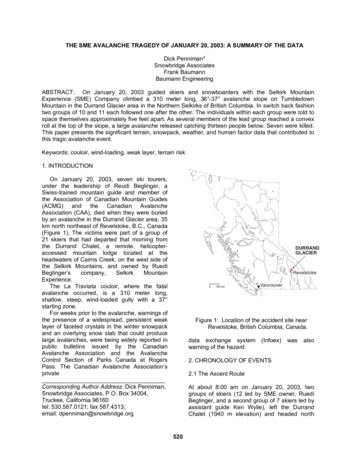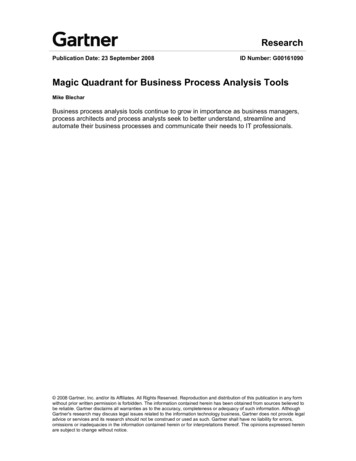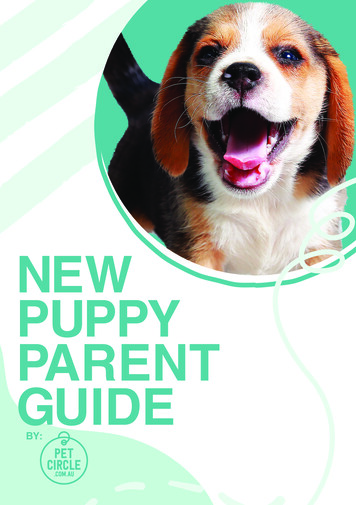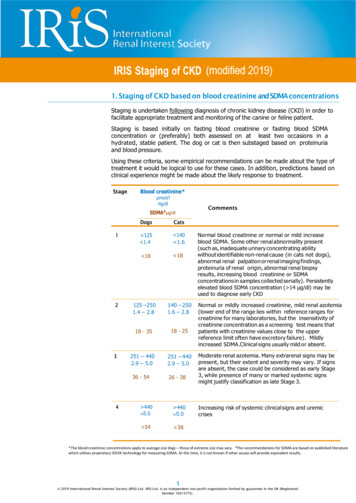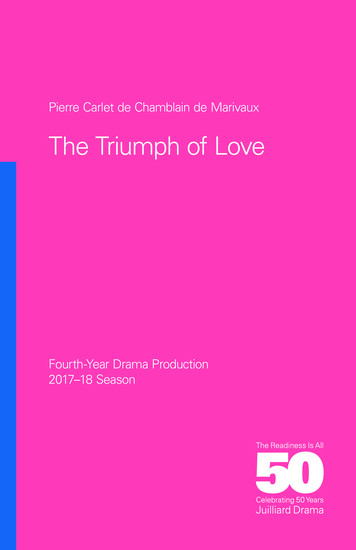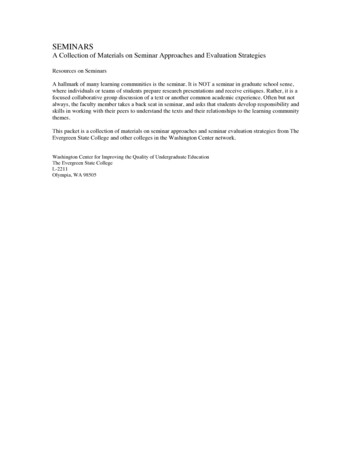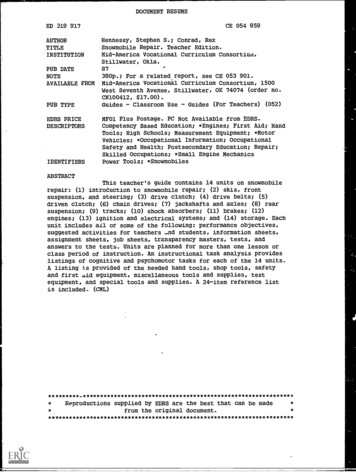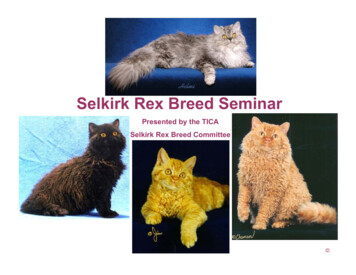
Transcription
Selkirk Rex Breed SeminarPresented by the TICASelkirk Rex Breed Committee
Selkirk Rex Breed Seminar Agenda: Selkirk Rex Breed Origins & History - (20-years worth) Status & General Description - (what we see) Genetics - (simple stuff, maybe) Breed Standard - (the perfect Selkirk – where is it?) Examples & Comparison - (the good & needs improvement) Exhibition & Handling of Kittens/Cats/Alters - (the fun stuff) Grooming & Showing - (our secrets - Judges “please leave”) The Future, Emphasis, Problems, Changes - (in our opinion) Contributors – (many thanks to those who helped)
Selkirk Rex Breed OriginsThe Breed began in 1987 from a shelter cat mom in Sheridan,Montana and one of her kittens. A local breeder (Jeri Newman)was asked to look at the “strange” kitten which exhibited a slightcurl on the coat. Jeri, who had an interest in feline geneticsadopted the kitten and later bred the kitten to one of her catteryPersians, Photo Finish of Deekay. On July 4th, 1988 the year-old“kitten” by then named Miss DePesto of NoFace delivered 6kittens. Surprisingly, 3 of the 6 kittens had a curly coat and theother 3 were straight-hair kittens. Thus the beginning of a Breed.This 50% ratio of curly offspring is exactly what would be expectedfrom a dominant gene for curl. This created even more interest inexploring the development of a new breed based on the curly-coattrait. Jeri selected one of her own family names, “Selkirk”; with thesame theme as the Cornish and Devon Rex regional names, theSelkirk mountains and a stream by the same name were nearby.So Selkirk Rex it is. After years of exhibition showing, the SelkirkRex was admitted to full Championship status by TICA in 1994.
Selkirk Rex - General DescriptionThe Selkirk Rex is produced by a (complete) dominant geneaffecting the guard, awn, and down hairs. The curl is mostprominent around the neck, underside, and rear in both coatlengths. Guard hairs tend to have a coarse texture especially overthe back, but the coat is very dense and overall soft and plush.The whiskers are curly as are the eyebrows.The Selkirk Rex is a medium to large cat with body longer thanlegs, in good balance, with a slight rise to the rear. Heavy boninggives the cat surprising weight. Females are less massive thanmales, but both sexes have round heads and prominent jowls.Kittens are curly at birth (especially the whiskers) and may losetheir coat and begin to develop an adult curly coat at 8-10 monthsof age. The coat continues to develop until about 2 years of age,so kittens with moderate coat type or length should be evaluatedmostly by head and body type. Whiskers become brittle and oftenappear broken off stubby hairs. Some Selkirks also molt, and coattexture is often seasonal and affected by hormonal influences.
Selkirk Rex Genetics for CurlPersian - Straightfor this example, “C” is dominant curly, “s” is recessive straightSire: PFD, Black PersianssCCsCs(50% Curly)DePesto sssss(50% Straight)MissDam: MDN, Curly, Blue Tortie/White,Domestic ShorthairSelkirk Rex - CurlyCsSR CCCCssCsss(75% Curly,25% Homozygous, 25% Straight)Oscar Kowalski of NoFaceCurly, Male, ShorthairThe first litter,July 4, 1988Selkirk Rex - HomozygousCCSR CCCCCsCsCs(100% Curly,50% Homozygous)
TICA, Selkirk Rex Breed Group StandardCategory III, Variant or Mutation Breed, All Categories & Divisions, and All Colors AcceptableHEAD- 40: Shape - 10: Round, full-cheeked, with round and broad forehead.Ears - 5: Medium-sized, rounded with pointed tip, set well apart.Eyes - 5: Large and round, set well apart.Chin - 2: Firm. Muzzle - 10: Short, square, visible beyond the cheeksCurly whiskers. Profile - 5: Rounded forehead, nose stop and firm chin.Neck - 3: Short and thick. Curly fur prominent on neck.BODY- 30: Torso - 10: Chest full, muscular, semi-cobby.Rectangular with a slight rise toward the hindquarters.Legs - 4: Medium length, substantial boning. Feet - 2: Large and round.Tail - 4: Medium length, thick, tapering to rounded tip.Boning - 5: Substantial. Musculature - 5: Substantial.COAT- 20: Length - 5: In both lengths, the curls are most prominent on the neck and tail. The curliness of the coaton the saddle area of the back is variable due to climate, seasons and hormones, especially in females.(SR): Medium (SL): Semi-long. Texture - 10: Soft and plush. (SR): Double coat, with thick undercoat and deepwaves with curled ends. (SL) Loose individual curls. Color - 3: Clear, intense colors preferred. Eye colorindependent of coat color. Pattern - 2: All patterns acceptable.OTHER- 10: Balance-2: Good proportions. Condition-3: Good muscle tone. Temperament-5: Sweet, loving.ALLOWANCES: Kittens may lack fully curly coat. White lockets acceptable. WITHHOLD ALL AWARDS: Nose break.DISQUALIFY:Temperament must be unchallenging; any sign of definite challenge shall disqualify. The cat may exhibit fear,seek to flee, or generally complain aloud, but may not threaten to harm. ACCEPTABLE OUTCROSSES (no time limit):American Shorthair, British Breed Group, Persian Breed Group
Selkirk Rex Examples & Comparison
HEAD, BODY, and COATThe Beginnings:Miss DePesto of NoFace“a work in progress, andthe 1st Selkirk Rex”Wide flat top head.Rocker ear set.Flat straight forehead.Extreme eye bias.High tapered cheeks,triangular head shape.Narrow muzzle.Slight boning.But, she had the keyingredient – an almostcurly coat.MDNThis cat is in the pedigree of every Selkirk Rex.
HEAD, BODY, and COAT3rd Generation fromthe original (Pest), andan early successfulaward-winning Selkirk.Good ear set, short,set wide, rounded withsemi-“rocker ears”.Eye set with slightdownward bias, butfully round when open.Checks semi-rounded,with good width.Good muzzle width,muzzle depth too “fat”from nose to chin.OSThis cat is in the pedigree of most of today’s Selkirk Rex.Spectacular coat,boning, and color.
HEAD and COATDTGood head roundness, balance of muzzle and eye placement.Good “matchbox” muzzle width (markings should not distort the shape).
HEAD, BODY, and COATLonghair KittenGood spacing to top,full round head shape.Great wide eye set, withacceptable slightdownward bias.Full, dense, heavy,coat.Heavy boning and goodsize.Overall, excellentrepresentation of theBreed, and the presentand future sire of manygood kittens.LZ
HEAD, BODY, and COATMFStrong eye bias. Good chest width and boning. Semi-rounded cheeks.Too much chin depth. Good coat density, color, and pattern.
HEAD and COAT14-week old Longhair kittenExcellent nose slope. Good profile, stop, and doming.Good cheek roundness. Wonderful curl.
HEAD and COATLonghair – 2 years old.Good ear set – upright andforward; ears too tall.Good eye width, slightdownward bias.Good stop and matchboxmuzzle shape and sizewith square alignment.Strong chin.Full, dense, heavy curl.Beautiful color – CreamShaded.JJFW
HEAD and COATYoung Adult ShorthairEye set with bias.Cheek boning tooangular, needs morerounding.Rectangular muzzle, withgood whisker pad.Muzzle may lack depth(thin chin).Nice curl, and strikingdeep blue color.HF
HEAD and COATLonghair – 18-months old.Lack of space between ears,forehead should be broader &more rounded – ears need toset upright, and forward.Good horizontal head structure.Perfect horizontal eye set. Fullopen round eyes.Rectangular muzzle, to centerof eye or beyond. “Matchboxlook”, square alignment – noseto chin.RJSSpectacular coat density &complete curl. Nice blue color.
Selkirk Rex Longhair, Homozygoushas bred 5 kittens (all curly).Type: Triangular head – narrow ear set,weak chin, pointed ears, slight boning.But, curly coat, and ALL CURLY KITTENS.Because this Selkirk lady is homozygous for curl, she will always havecurly kittens, making her especially valuable to a Selkirk Rex breedingprogram, but the type needs improvement.CS2
Homozygous Male(young shorthair)“Improved” overall type (fewerangles, more roundness). Bettercompliance with the standard.Semi-“Rocker ears” - set too farout and tilted out. Head semirounded.Good horizontal eye set and fulleye roundness.Muzzle needs more rectangular“match box” shape and shouldbe as wide (including whiskerpads) as center of eyes.Very much improved type overprevious homozygous examples.The “zygotes” are getting better.YZ
Exhibition & Handling of Kittens/Cats/AlterFor your handling enjoyment, we have:4 Adults - 1 Shorthair, 3 Longhairs7 Kittens - 4 Shorthairs, 3 Longhairs
Selkirk Rex GroomingWe are often asked if the coat mats; practically any coat will mat(especially longhairs) if not periodically groomed. Combing withthe largest (long wide tooth, for longhairs) comb you can findworks well. Back to front combing, while working the comb to skinlevel works best, and gentleness helps the most. Even non-showcats, should be regularly bathed; this helps with coat maintenance.The bath process is: thoroughly comb, clean the ears, thoroughlywet/rinse, apply degreaser (if needed), rinse, normal shampoo,rinse, a color enhancer/brightener (if needed), rinse, perhaps afinishing shampoo, and several rinses, and rinse some more. MostSelkirk exhibitors do not use any conditioner or “top coating.” Agood, full-curl coat does not require any additives; it will feelwonderfully soft as is, once it dries. Do not blow dry; after a toweldrying, the coat will air dry on its own and look and feel great.After drying, another combing is sometimes helpful, and afterwardthe coat can be water spritzed or rubbed down with a damp cloth,and when dry, the curl will bounce back. Truly - a wash & wear cat.
Selkirk Rex ShowingThe Selkirk Rex is an easy cat to groom, and therefore an easy catto show well. The bath routine does not need to be done daysbefore to allow the coat to “recover” for best appearance. Thebath can be done the night before the show, which may bepreferable since the curls in the coat tend to collect debris,especially litter particles. This is the result of the curls acting as“pickup and sweeping devices.” Because the hair is not straight,debris tend to remain in the coat rather than fall out.At the show (between rings), some exhibitors lightly water (noconditioners or additives) spritz the coat and scrunch the back,side, and flank hair to enhance the curl. This requires good timingsince the hair should be dry for judging. From experience, thebiggest problem during the show is maintaining a clean coat dueto the tendency of the curly hair to pickup small particles (mostlylint and litter). Combing during the show is discouraged as it maytemporarily straighten the hair, but it will bounce back with a waterspritz, scrunch, and dry. The wash & wear cat – they're amazing.
The Future, Emphasis, Problems, ChangesRefine the Breed Standard. Add points for curl, eliminate points for“other”, reword: rectangular muzzle, body longer than legs, and betterdescribe the ear (“round with pointed”?) and eye shape when open. Encouraging more Selkirk to Selkirk breeding. Developing healthy homozygous type to Breed standard. Blood Type A & B incompatibility – no statistics for SR/SL, butPersian estimated at 14% type B, and British Shorthairestimated at 25% - 50% type B.The solution : Type Testing PKD inheritance – common (25% - 40%) in Persians.The solution : DNA Testing Expiration and changes in permissible outcrosses.(American Shorthair, British Shorthair/Longhair, Exotic Shorthair, Persian/Himalayan)
Seminar Contributors:Thank you for your help and encouragement.Jeri Newman, Montana (the Breed originator)Joann Bainter, Arizona (cats)Natasha Berry, Washington (images)Mary Jones, Wisconsin (images)Debi Kallmeyer, California (advice & images)Lynn Landers-Dickinson, Iowa (images)Nancy McMullen, Minnesota (images)Pam Sharp, Idaho (advice & images)Patricia Simmes, Arizona (cats & images)Debra Sutherland, Texas (advice, cats & images)Karen Williams, Arizona (images)Arnold Farley, Colorado (cats, images, author & seminar presentation)Like the Selkirk Rex, this document is a work in progress; please send any changes,comments, or suggestions to: Arnold, E-Mail: WHF@comcast.net November 2009 by Arnold Farley
Selkirk Rex Breed Seminar Agenda: Selkirk Rex Breed Origins & History - (20-years worth) Status & General Description - (what we see) Genetics - (simple stuff, maybe) Breed Standard - (the perfect Selkirk - where is it?) Examples & Comparison - (the good & needs improvement) Exhibition & Handling of Kittens/Cats/Alters - (the fun stuff)




